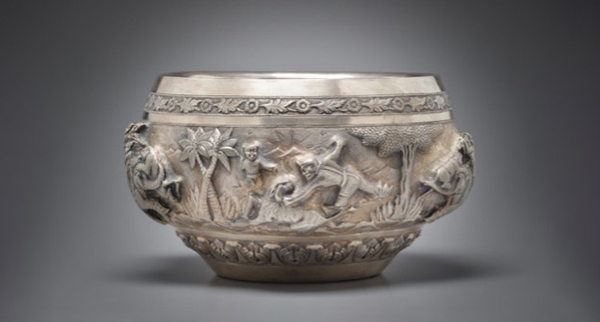Silver for the British Raj in India
The period of the British direct rule of India or The British Raj as it was known (1858-1947) closely followed the Indian Rebellion of 1847. The rebellion came about as a result of an accumulation of different factors over time, including resentment over army promotions and deployment abroad, reforms and taxes, so tensions were already running high.
The system of governance was instituted alongside the transfer of the rule of The East India Company to the Crown, which at this point was headed by Queen Victoria. This resulted in the economies of Great Britain and India becoming even more entwined than in the previous years. The construction of improved railways, roads, canals and bridges under British rule greatly eased the transport of raw materials alongside finished products for import and export between the two nations.
Although the British had been in India since the 1600’s, there came the birth of a new middle class around 1880 following this establishment of direct British rule. The residences of this section of society were opulent and of impressive proportions. The acquisition of fine goods and with it the show of affluence and taste within the home became a new pastime. With the timeless beauty and decadent ornamentation, silver was the perfect choice of work of art to showcase.
The first generation of merchants favoured the more elegant and simpler lines of silver of the Georgian era. During the tour of India by the Prince of Wales in 1875/76, he was presented with a fine and elaborately decorated silver tea service, alongside further beautiful items of Madras silver, some of which were produced by the famous and well renowned company of P. Orr and Sons.
After arriving in Madras in 1843, Peter Orr and brother Alex found work with Gordon & Co as watchmakers, (their original business in Edinburgh) taking over the business in 1849 following the retirement of the owner. Business flourished and it became the most prominent and well thought of silversmith company in Southern India. Silver produced in and around Madras is normally decorated in what’s known as the Swami style, often depicting Hindu gods within sacred scenes.

Following the return to Britain of the Prince of Wales, the fine tea service was exhibited to much acclaim. The Colonial and Indian Exhibition which took place in South Kensington in 1886 is reputed to have attracted an incredible 5.5 million visitors.
Displaying the processes and craftsmanship of their work within the exhibition were a number of Indian artisans which must have been compelling viewing.
The silversmithing companies of India began to be inundated with requests for new commissions for the silver of forms favoured by the British – tea services, punch bowls and salvers amongst others. But change was in the air and the taste for the Indian style of ornate and richly embossed decoration grew even further. These sumptuous items now adorned the homes of British families in many cities of India.
The major cities and surrounding villages had design and ornamentation often peculiar to the area which these days may make them instantly recognisable although designs and details were copied all over!

The silver of Lucknow often depicted scenes of a hunt before a jungle background, they also sometimes had the charming presence of a ‘hallmark’ engraved on the underside, often an elephant or peacock.

Kutch silver is usually very ornate and profusely embossed with scrolling foliage, often with a blank cartouche.
The highly regarded company of Oomersee Mawjee, based in Bhuj, produced a fantastic quality of work and was another favourite silversmiths, with commissions coming from high-end companies such as Liberty & Co.
The well-established firm of Birmingham silversmiths, Elkington and Company, started producing items based on Kutch designs after the strict British hallmarking put a stop to the import of some Indian-made pieces. Silver produced in or imported into the U.K has to pass strict tests in which all of the finished products have to contain a minimum of 92.5% pure silver. Much Indian silver was of a lower purity so failed to pass the strict tests and was often scrapped.

Normal decoration for silver from Calcutta would be various farming scenes, and often depicted small dwellings amidst palm trees in the background. Dass & Dutt and Hamilton & Co were both well renowned companies working out of Calcutta and much favoured by the Indian aristocracy. The marks of the latter changed over many years but always included a small and charming stamp of an elephant.

Due to Kashmir being famous for textile weaving, the inspiration is apparent on the silver produced here. Often coriander leaves, floral and paisley type patterns form part of the repoussé work, but in addition earlier middle eastern inspiration can be detected.
In the world of silver, fashions have changed countless times over the past years and more recently the taste for richly ornamented goods has dwindled with the popularity of iconic and more restrained mid-century design but these fabulous decorative pieces are testament to the craftsmen of all backgrounds and are an important link to the history of silver production in India.

To see more, visit The Victorian & Albert Museum, which showcases fabulous examples of Indian silver. For further reading on this subject, check out Delight in Design by Vidya Dehejia and Indian Silver 1858-1947 by Wynyard Wilkinson.

Fiona moved south from the Highlands of Scotland in 1996 to study for the Christie’s Postgraduate Diploma in Decorative Arts at Glasgow University. A move to Edinburgh followed where she was delighted to be offered a position within the Silver and Jewellery department of Bonhams Edinburgh, where she remained for 23 years.







